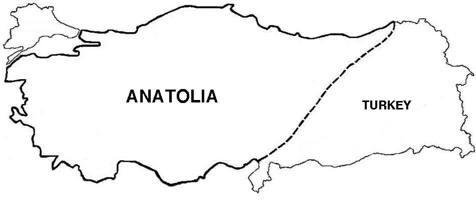
|
The Society of Folk Dance Historians (SFDH)
Dance and Music of Anatolia
[
Home |
About |
Encyclopedia | CLICK AN IMAGE TO ENLARGE |


|
 From the earliest times, music has been an important part of life in Turkey. There is a long tradition of folk music of many types among Turkic peoples wherever they are found. There also is a long tradition of "classical" or art music.
From the earliest times, music has been an important part of life in Turkey. There is a long tradition of folk music of many types among Turkic peoples wherever they are found. There also is a long tradition of "classical" or art music.
Turkish folk music originated on the steppes of Central Asia, and like folk music all over the world, has constantly changed and evolved as it is interpreted by different performers. Yet, there are some songs that have been sung for centuries. Although folk music was not notated until recently, musical traditions have been kept alive by "ozanlar" and "aşik" (wandering minstrels).
Dance and dance music is extremely varied in Anatolia; there are dance forms that were brought into Anatolia by the Turkic tribes, and there are dance forms that have originated in Anatolia. As a result, each region has its own folk dances; there are more than 3,000 known folk dances from Anatolia! Dance forms can be distinguished by their figures, the musical accompaniment, the costuming, and the dance style.
Typical of the Aegean region are Zeybek dances that are danced by colorfully-dressed male dancers called "efe" who symbolize courage and heroism. In the early part of the 20th century, this type of dance was introduced into Greece by immigrants, where it has developed its own distinguishing characteristics under the name Zeimbekiko. Also, from west and southwest Anatolia are the spoon dances, wherein dancers click out the dance rhythm with a pair of wooden spoons in each hand. In Bursa, there is a sword-and-shield dance that portrays the conquest of the city. It is danced only by men, who are dressed in early Ottoman battle-dress, and who dance only to the sound of their clashing swords and shields.
 In the Black Sea region, there is a type of dance called Horon, danced by men in black costumes with silver trim. Both the costumes and the dances are very similar to Pontic dances. The dancers join hands with their arms curved at shoulder level, and then quiver to the vibrations of the "kemençe," a three-string fiddle that is played vertically and held away from the body. A good "kemençe" player will dance along with the rest of the dancers, being just as vigorous as any of them, and, just for good measure, will sing while he is dancing and playing. Not for the faint-hearted!
In the Black Sea region, there is a type of dance called Horon, danced by men in black costumes with silver trim. Both the costumes and the dances are very similar to Pontic dances. The dancers join hands with their arms curved at shoulder level, and then quiver to the vibrations of the "kemençe," a three-string fiddle that is played vertically and held away from the body. A good "kemençe" player will dance along with the rest of the dancers, being just as vigorous as any of them, and, just for good measure, will sing while he is dancing and playing. Not for the faint-hearted!
Kavkaz dances, such as the famous Şeyh Şamil, are done in the eastern part of Anatolia (Kars), and throughout the area in and around the Georgian, Armenian, and Azerbaijani Soviet Republics. Şeyh Şamil depicts the struggles of the Turks, Georgians, Daghestanis, and others against the Russians.
In the east and southeast are Kurdish dances, such as the Halay, and Armenian dances, such as the Bar. The Halay is danced with a close armhold and short lines of dancers. The Armenians also dance Kavkaz-type dances, both in couples and for men only, but with their own special features and style.
The traditional instruments for folk music in Anatolia are still very popular today. Of the various kinds of string instruments, those that are played with a "plectrum" (pick) are called Saz. These come in many configurations and bear names, such as "cura," "ağlama," "tambura" (a name that has been adopted for this type of instrument in the Balkans), "divan," "kopuz," "bozuk" (that has become popular in Greece as the "bozouki"), and "meydan." We have already mentioned the "kemençe," which is played with a bow.
Among wind instruments, by far the most important is the "zurna," a wooden instrument that has a reed made from a tubular piece of cane. The cane is flattened so as to form what is misleadingly called a double-reed. There are two vibrating surfaces, hence double, even though the reed is in one piece; oboe and bassoon reeds also are called double-reeds as they are made in two pieces. This instrument has been in continuous use for a very long time, and over a very large geographic extent. It is one of the most common musical instruments in the world; it is found in India (and even farther east) under the name "şanay," all through the Middle East ("mizmar," "kerena"), through Anatolia ("zurna"), North Africa ("zukra"), and the Balkans ("zurla"). There are variations in the size and decoration of the instrument, but the structural details are virtually identical over that entire geographic extent, a regularity almost unique in the world.
The technique of playing the "zurna" is similar in all of these places as well; the most prominent feature is the use of the cheeks and mouth cavity almost as a 'bag' on a bagpipe. Air is inhaled through the nose into the lungs; during the inhaling process, the air stored in the cheeks is used to keep the sound coming. The result is a continuous sound, with no interruptions for breathing! It is believed that the instrument was spread, together with its playing technique, by the Romani as they moved westward from their original homeland in northern India.
The "zurna" in Anatolia, as well as in most of its other homes, is inseparable from the double-headed bass drum called the "davul" (also "tŭpan," "tapan," "daul," "tabl," and many other names in various places). The combination of "zurna" and "davul" is used mostly outdoors – they are quite loud – and are still played in almost every village in Anatolia. In the cities, as well, we heard "zurna" and "davul" being played at a wedding in İstanbul. It is said that without the "zurna" and "davul", a wedding cannot be a wedding!
Another interesting musical style was connected with the "Yeniçeri" (literally "new corps," known in English as the Corps of Janissaries). This was a special organization within the Ottoman army. They developed their own type of military band called the "Mehter." It consisted of "zurnas," brass instruments, singers, and a wide variety of percussion instruments. The "Mehter" travelled with Ottoman armies as far west as Vienna, and had a profound influence on European art and music. Many Western orchestra instruments, especially in the percussion section, are derived almost directly from "Mehter" instruments.
In addition, European composers (including Mozart and Beethoven) have acknowledged incorporating "Mehter" musical themes into some of their most famous pieces. The "Yeniçeri" (and the "Mehter") was dissolved by the Sultan in 1826. The tradition has been kept at least partially intact through reconstructions. The first attempt at a reconstructed "Mehter" was in the early part of the 20th century, and has been undertaken regularly since then. This reconstruction is not as difficult as it might seem, as the "Mehter's" repertoire had been notated for quite some time, and there are training manuals and observer descriptions for earlier times. In İstanbul, you can still hear the "Mehter" play; there are about sixty performers in spectacular costumes. During some Ottoman campaigns, there were reportedly as many as five hundred performers at times!
There is a very old and well established tradition of classical or art music in several Mid-East and Central Asian cultures, including those of the Turks, the Iranians, and the Arabs. The term classical music here is used analogously to the way in which we use it in the West: the study of a set, special repertoire of pieces, largely by known composers (although this is not true for Iranian music), learned through formal training with the intent of their being performed for others. Of course, the repertoire of pieces and the instruments used to play Turkish classical music are completely different than for European classical music. This Turkish classical music is played wherever Turkic people have settled. For example, the Uzbeks are a Turkic people living in Central Asia, and portions of this same repertoire are played there, as well as in Anatolia.
The instruments used in Turkish classical music include the "nay" (a long reed pipe that is blown across the end), the "tambur" (a large string instrument with frets, played with a pick), and the "kemençe," although it is also a bowed instrument. Just to add to the confusion, the Iranians have an instrument in their classical orchestra that they also call "kemençe," but it is different from either of the Turkish "kemençes," and small drums called "kudüm." Religious orders, such as the "Mevlevi" (known as the Whirling Dervishes) and the Bektaşi have helped to maintain this musical tradition.
This is only a small sample of Anatolian music. There are many other recognized traditions and styles, such as the popular/semi-classical styles, that include the use of instruments such as the "ud," the "kanun," the "darbukka," and (more recently) the clarinet and violin. Fortunately, all of these musical traditions are still thriving in Turkey today.
DOCUMENTS
Used with permission of the authors.
Printed in Folk Dance Scene, January 1984.
This page © 2018 by Ron Houston.
Please do not copy any part of this page without including this copyright notice.
Please do not copy small portions out of context.
Please do not copy large portions without permission from Ron Houston.